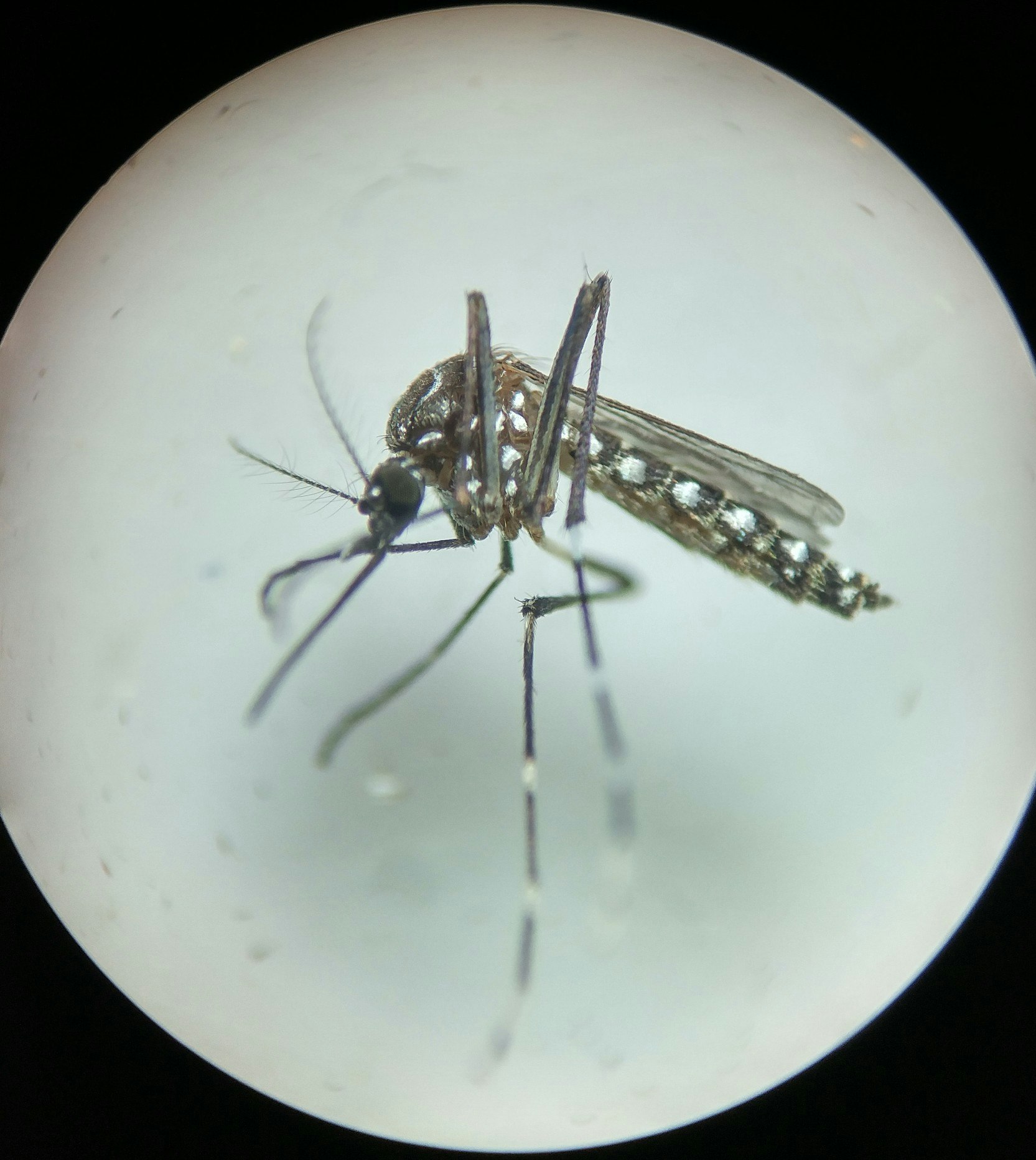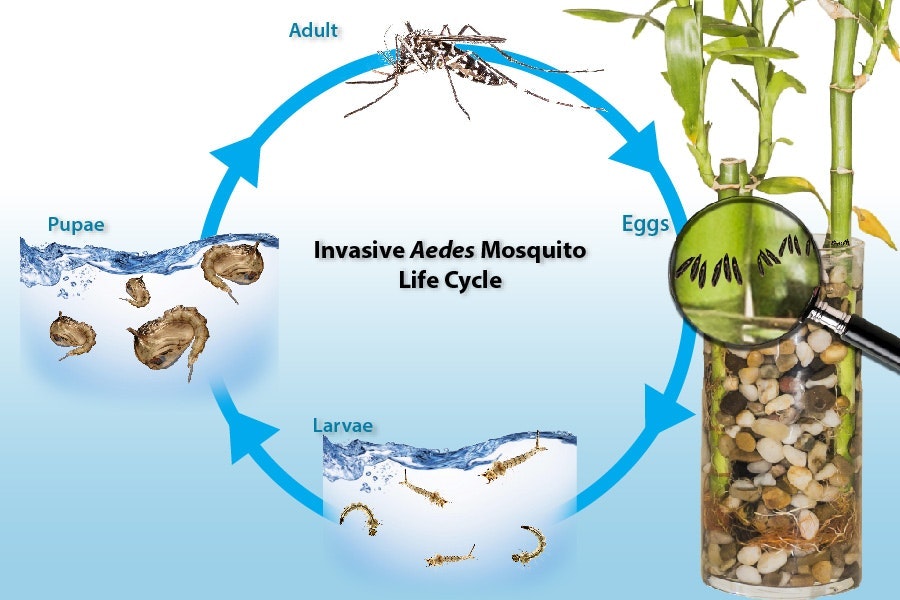Invasive Aedes Mosquitoes

In 2018, the District first detected the presence of invasive Aedes mosquitoes in Lancaster, CA. Since that initial detection, the population of this mosquito has taken hold in the Antelope Valley and has been detected all throughout Distict boundaries including Palmdale, Lancaster and Quartz Hill. The big rain storms in the summer of 2023 caused a large uptick in the presence of the invasive Aedes mosquito and residents have noticed their presence in a big way during both the 2024 and 2025 warm season.
The Aedes mosquito differs from the native Culex mosquito in several ways:
1.) Aedes mosquitoes breed in very small 'container-like sources of stagnant water usually in yards or on balconies. Think: yard junk, plant saucers, old/unused tires, plant saucers, watering cans, children's toys and buckets.
2.) Aedes eggs stay viable dry whereas Culex eggs don't. So, with Aedes mosquitoes, even if the water source dries out, the egg will stay stuck to the container and hatch once they are re-exposed to water. Scrubbing containers to dislodge eggs or throwing unused containers away entirely will help reduce the presence of this mosquito.
3.) Aedes mosquitoes prefer people as their bite of choice. Our native Culex mosquitoes prefer to bite birds, but will bite humans if their preferred bird source is not available. Because of their biting habits, Aedes mosquitoes are very noticeable in communities.
4.) Aedes mosquitoes are aggressive, daytime biters that tend to probe multiple times to find a good blood vessel. This repeated poking increases irritation and introduces more saliva, making their bites more noticeable. People are also often intolerant to their bites because Aedes mosquitoes inject more potent saliva when they bite. Their saliva contains a mix of proteins and enzymes that help them feed on blood—but these same compounds trigger stronger allergic and inflammatory reactions in humans. The result: more itching, redness, and swelling.
5.) Aedes mosquitoes carry different diseases than our Native culex mosquitoes. Aedes mosquitoes cannot carry or transmit West Nile virus like the Culex mosquito, but they can carry other tropical diseases such as Dengue fever, Zika virus, Chikungunya, and Yellow Fever. To date, Public Health has not detected the presence of disease circulating in the Aedes mosquito population within our District boundaries. There have, however, been several detections of local Dengue fever transmission in various other areas of LA County, Long Beach and the San Gabriel Valley.
6.) Not all mosquito-borne diseases spread the same way. West Nile virus is carried by Culex mosquitoes. When they bite a person, the virus can make that person sick—but it stops there. Humans don’t have enough virus in their blood to pass it back to other mosquitoes, so we’re a “dead-end host.” Diseases like dengue, Zika, and chikungunya are different. They’re spread by Aedes mosquitoes, which love to bite people. After being infected, a person’s blood can carry enough virus that another Aedes mosquito can pick it up when it bites that person—and then the mosquito can pass it on to someone else. That’s why controlling Aedes mosquitoes is so important: when people get sick, they can keep the cycle going.
All of these characteristics combined make the Aedes mosquito a particularly annoying pest for residents, but also an extremely hard pest for the District to mitigate. Keeping this mosquito population lowered relies heavily on the participation of the community in keeping their own properties clean and free of possible stagnant water sources that can breed mosquitoes.
The District operates by treating large, predictable public sources of stagnant water throughout our District boundaries. Since we cannot access people's yards in the same way we access public sources of stagnant water, we ask the the public be particularly vigilant with their own personal mosquito control measures, especially when dealing with Aedes mosquitoes.
Click HERE for a detailed checklist of common items that often beome a source of mosquitoes. Look for them and and eliminate them to help rid your yard and home of mosquitoes.
Do you happen to have any of these mosquito sources around your house or yard?
Defunct fountains, plant saucers, kids toys, bird baths, yard clutter, bromeliad plants, aquatic plants (such as Lucky Bamboo), trash, recycling and old tires are common sources of Aedes mosquitoes!
.png?ixlib=rb-1.1.0&w=2000&h=2000&fit=max&or=0&s=811fc3b85bdb32aff3db55e3211ef734)
Aedes (pronounced "aid-dees") mosquitoes are aggressive, black-and-white insects that thrive in our cities. They've been nicknamed "ankle biters" due to their tendency to bite people on the lower portion of the body. These are not your common Southern House mosquitoes - or Culex - which we are accustomed to and are light brown in color.

Aedes love humans, but not just for our blood 🩸. Our communities and homes inadvertently provide the perfect sheltered hangout spots and breeding sources for Aedes mosquitoes that seek out containers to lay their eggs in. After taking our blood, female mosquitoes search for stagnant water in many types of containers 💦 to lay their eggs!
What's The Big Deal About Aedes Mosquitoes Anyway?!
Aedes mosquitoes are a mosquito of particular public health concern because their human focus makes them powerful disease transmitters in cities and neighborhoods.They are efficient at transmitting (spreading) several fatal human arboviruses including chikungunya, dengue, Yellow Fever and Zika virus. In recent U.S. history, Aedes mosquitoes were responsible for Zika outbreaks in Florida, Texas, Hawaii, and Puerto Rico. Although there have been no instances of local transmission of any of these tropical diseases yet, the potential for these diseases to make their way into the population is very real. If you travel (Europe, Asia and South America), please be aware you could be a carrier of these diseases and not know it! If a local Aedes mosquito bites a local person who is infected with one of these tropical diseases due to their travels, the disease could potentially enter the local mosquito population. In October of 2023, for the first time in California history, Dengue fever was found to be circulating in the Aedes mosquito populations and caused transmission in people in both Pasadena and Long Beach. In 2024, additional local transmission of Dengue fever was detected in Baldwin Park and Panorama City.
View the full article on 2023 CA Dengue fever transmission HERE
✈ BE SURE TO CHECK OUT THE CDC TRAVEL ADVISORIES PRIOR TO TRAVEL ✈
How Do I Know If Aedes Are Living Around My Home? 🏡
- You or a family member receive mosquito bites during the daytime hours - and not just morning or evening when our Native Culex mosquitoes typically bite.
- Mosquitoes are biting indoors (office, home, garage, etc.)
- You notice black-and-white adult mosquitoes about the size of a pencil eraser head.
How Do I Keep Them Out of My Home? 🏡
Tip n' Toss 💦
Aedes are known as 'container breeders' because they tend to breed in small, unsuspecting containers. Tip out any stagnant water, and toss out unused containers. All mosquitoes require stagnant water to lay their eggs and grow. Eliminating stagnant water around your home prevents mosquitoes from developing in the first place. This is called “source reduction.” If done weekly, source reduction is much more effective at eliminating mosquitoes than using any pesticides!
Talk to your neighbors 🤝🏽
In order to reduce the population and control the nuisance, residents must take responsibility for their own yards and work with their neighbors to do the same. Make mosquito source reduction a part of your weekly routine. Together we can keep a healthier Antelope Valley.

How did invasive Aedes mosquitoes get here?🤷🏽♂️
In 2018 our staff identified a thriving population of Aedes aegypti (one type of Aedes mosquito) in the city of Lancaster. The mosquito eggs were inside a bucket of landscaping rocks that was relocated from an Aedes infested area from Northern Los Angeles County. The bucket got inadvertently filled with sprinkler water and the eggs were able to hatch. From there, the mosquitoes were able to use stagnant water in flower pots, planters, aquatic plants (even indoors) and over-watered vegetation surrounding people’s homes to continue laying eggs. In subsequent years, Aedes aegypti have been located in several other areas of Lancaster and Palmdale and in 2021, Aedes mosquito detections increased more than tenfold from 2020. The summer storm Hilary in 2023 provided the perfect conditions to allow the Aedes mosquito population to boom. The Antelope Valley is feeling the impact of these pesky mosquitoes on the community.

.png?ixlib=rb-1.1.0&w=2000&h=2000&fit=max&or=0&s=5bd308a584a50c7807d13dc421e8898e)
Aedes Mosquito Detections the the Antelope Valley 2018-2023:
.png?ixlib=rb-1.1.0&w=2000&h=2000&fit=max&or=0&s=55bbd8346d5f20395de2d24e8a963148)
